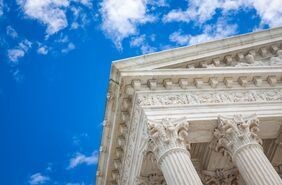Autonomous Vehicle Incidents: Where Things Are Going in Liability Allocation
Client Alert | 5 min read | 07.13.18
Two fatal accidents involving semi-autonomous vehicles took place in March 2018, increasing the number of reported deaths associated with self-driving cars in the public mind to at least four, and intensifying the focus of AV industry participants upon the legal claims they may face going forward. Notwithstanding the closed settlements that have resolved liability with respect to the most high profile accidents, every accident and incident involving AV technologies offers insights on how liability will be allocated in the emerging landscape.
To illustrate, consider the following scenario:
A rental car company rents SUVs with autonomous features. The SUVs include an array of cameras, radar, LIDAR, navigation sensors, and a computing and data storage system. In autonomous mode, the SUV can drive itself under normal street and highway conditions. The manufacturer markets these autonomous features as “Advanced Autopilot.” The rental car company also installed an aftermarket entertainment system, which allows the driver to stream movies and TV shows while the SUV is in autonomous mode.
The SUV is also equipped with a variety of advanced safety features when the vehicle is being operated by the driver, including an emergency braking system that automatically applies the brakes when an object is detected in the vehicle’s path and a collision is likely. The emergency braking feature is disabled when the SUV is in autonomous mode, however. This is required to avoid “false positives” where the vehicle's brakes are applied needlessly while in autonomous mode. But if the system detects the need to apply emergency braking while in autonomous mode, it will send a visual cue to the driver to take control of the vehicle.
An individual rents one of the SUVs from the rental car company. The driver puts the car in autonomous mode and begins traveling on a four-lane road. The vehicle approaches a crosswalk at 35 mph while a pedestrian is crossing. The vehicle’s detection systems identify the pedestrian and send a visual cue to the driver to apply the brakes. However, the driver is watching a movie on the entertainment system and does not see the visual cue. The car strikes and kills the pedestrian.
Who might face legal claims for this accident?
Vehicle Manufacturer: The vehicle manufacturer, which had overall responsibility for the design and production of the vehicle, could face claims based on a variety of legal theories, including strict products liability for design or manufacturing defects or failure to warn, negligence, breach of warranty, or other statutory claims. In this scenario, a plaintiff might argue that the vehicle manufacturer is liable because it intentionally chose to disable the vehicle’s emergency braking feature to avoid “false positives” where the vehicle brakes needlessly while in autonomous mode. A plaintiff may also point out that the manufacturer marketed the vehicle’s autonomous features as “Advanced Autopilot” despite the need for the driver to still pay attention while the vehicle is in autonomous mode.
Component Suppliers: The companies that supplied the vehicle’s autonomous features, such as the radar, LIDAR, camera array, navigation sensors, and computing and data storage systems, may have a solid defense to potential claims in this scenario—the products they supplied worked properly and the accident may have been avoided but for actions taken by others. But what if poor lighting or unique weather conditions caused the system to fail to identify the pedestrian and alert the driver that a collision was imminent? These companies could face many of the same claims as the vehicle manufacturer under such circumstances.
Entertainment System Supplier: Like the other component suppliers, the entertainment system supplier may also seek to defend under these facts by pointing at the rental company as the installer of the entertainment system in the vehicle. But since product manufacturers can be responsible for foreseeable uses of their products when installed properly, regardless of who installs it, designing an entertainment system that does not meet regulatory expectations with regard to driver distraction and distracts drivers from receiving vital information may expose these companies to additional claims. To date, such claims have not been successful and consumer education on avoiding driver distraction is so pervasive that such claims will likely not have merit.1
Rental Car Company: Although the rental car company may not be subject to strict liability for manufacturing or design defects, it still has a duty to properly maintain its vehicles and not make any modifications that make the vehicle unsafe. Here, a plaintiff may claim that the rental car company outfitted the autonomous vehicle with an entertainment system that arguably caused the driver to miss a crucial visual cue that could have helped avoid the accident. In fact, a ride-hailing service testing autonomous vehicles recently reached a settlement with the family of a pedestrian who was struck and killed by one of its AV test vehicles, and a report on the incident showed that the test driver was streaming Hulu before the crash.
Insurers: Notwithstanding the autonomous features of the car, the accident was caused, at least in part, by human error: i.e., the driver’s failure to heed the instruction to brake because he was distracted by the aftermarket entertainment system. In that respect, this incident is no different from most other car accidents -- 94 percent of which, according to the NHTSA, result from human error. Accordingly, the liabilities arising out of this accident, as with most other car accidents, are likely covered by auto insurance. This would include auto policies issued to the driver, the rental company, and/or any third party, such as an employer, which (depending on the purpose for which the car was rented), might be deemed vicariously liable for the negligence of the driver.
On the other hand, the causative factors attributable to the autonomous features of the car in this incident set it apart from “traditional” car accidents, which are rarely if ever caused by defective vehicular equipment of any kind. The cutting-edge hardware and software products that combine to produce an autonomous vehicle will invoke the potential for coverage under an entirely different type of insurance product from that specific to automobiles: product liability coverage issued to the manufacturers and distributors of the component equipment.
Takeaways:
- As responsibility for accidents shifts away from drivers and towards the companies that design, manufacture, and maintain autonomous vehicles, the pool of companies potentially liable for accidents will deepen. Companies need to consider potential liability risk when designing autonomous vehicle-related systems and partnering with other companies.
- The development of autonomous cars will likely incentivize insurers to increase their focus on the market for product liability coverage. That being said, driver error is still very much a factor in assessing liability for incidents involving semi-autonomous vehicles, and can be expected to remain so for many years to come. Accordingly, while the market for product liability coverage can be expected to expand, the substantial sector of insurance industry revenues attributable to personal and commercial automobile insurance is likely to remain robust for the foreseeable future.
1 Modisette v. Apple, Inc., Case No. 16-CV-304364 (Ca. Super. Ct. 2017) (dismissing case where plaintiffs alleged that Apple, a cell phone manufacturer and application developer, had a duty to prevent its users from using certain cell phone applications while driving, based on injuries caused by a distracted driver who had been using the iPhone’s FaceTime application).
Contacts
Insights
Client Alert | 3 min read | 09.04.25
Not Just the FAR, SAM.gov Gets Overhauled Too
The System for Award Management (SAM, available at sam.gov) is set to incorporate Revolutionary FAR Overhaul (RFO) changes as early as the first quarter of 2026. The RFO process, which began earlier this year, will trigger matching changes to representations and certifications in SAM.gov.
Client Alert | 2 min read | 09.03.25
Client Alert | 5 min read | 09.03.25
If You’re Not First, You’re Last: Federal Circuit’s First Review of an AIA Derivation Proceeding
Client Alert | 2 min read | 09.03.25




